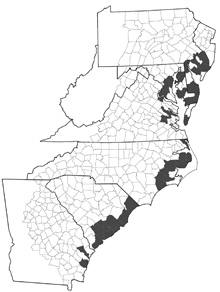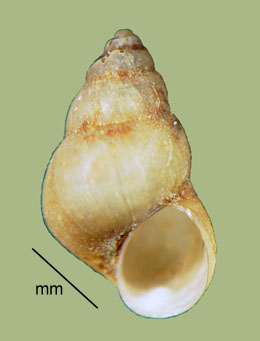> Habitat & Distribution
This is an easily-overlooked inhabitant of an environment that can be difficult to sample. Hershler & Thompson (1992) gave the range of L. tenuipes as "New Jersey south to Campeche, Mexico," extending through the West Indies. The US National Museum holds collections made as far north as Maine (Smith 1987).
Throughout this extensive range, Littoridinops populations are characteristic of coastal rivers and estuaries, especially freshwater tidal marshes. Our samples generally come from the blades of emergent vegetation, especially Typha, and floating organic debris, although they may be found on hard sand bottom down in Florida (Thompson 1968). FWGNA incidence rank I-4.
> Ecology & Life History
Hydrobioid snails seem to be rather nonspecific grazers of small particles (Dillon 2000: 94-97). They are typically dioecious; the males being characterized by a penis that arises from the neck, females typically attaching single eggs in spare, hemispherical capsules to solid substrates (Hershler 1994).
We are unaware of any good study specifically directed toward the ecology of Littoridinops. Data on the range of salinity tolerated would be especially welcome. Our limited collections in Atlantic drainages have generally been made from waters that were, to judge by their vegetation and savor, entirely fresh. But L. tenuipes populations also range into brackish waters, occasionally up to 16 ppt in Florida (Thompson 1968), an environment from which we have very few observations.
> Taxonomy & Systematics
Originally described as Amnicola tenuipes by the Georgia naturalist J. Hamilton Couper in Haldeman s (1842 45) monograph, the species was transferred by Pilsbry to the South American genus Littoridina, new subgenus Littoridinops, in 1952. After some 170 years of residence in the large and ever-expanding Hydrobiidae (Kabat & Hershler 1993), Littoridinops was segregated into the new family Cochliopidae by Wilke and colleagues in 2013.
The penis of L. tenuipes is typically cochliopine, fringed with numerous papillae. See Thompson (1968) for a thorough review of the morphology and anatomy, Hershler & Thompson (1992) for a broad-brush review of Littoridinops within the larger context of the Cochliopidae, and Liu et al. (2001) for a molecular phylogenetic analysis of the family.
A pair of L. tenuipes CO1 sequences from Maine contributed by Hershler et al. (2007) demonstrated 99% sequence similarity to a pair of sequences contributed by Georgia researchers. This set of four are around 97% similar to a larger set of L. monroensis sequences deposited into GenBank from Florida, Mississippi, Maryland, and San Francisco (Hershler et al. 1999, Wilke et al. 2001).
> Maps and Supplementary Resources
- Littoridinops distribution in Atlantic drainages (2023)
- Distribution of cochliopid populations in Georgia & the Florida panhandle (2025)
> Essays
- Earlier versions of this website, online until August of 2016, adopted the large, broadly-inclusive concept of the Hydrobiidae (sl) following Kabat & Hershler (1993). More recently the FWGNA project has shifted to the Wilke et al. (2013) classification system, distinguishing a much smaller Hydrobiidae (ss) and elevating many hydrobioid taxa previously ranked as subfamilies to the full family level. For more details, see The Classification of the Hydrobioids.
> References
Dillon, R. T., Jr. (2000) The Ecology of Freshwater Molluscs. Cambridge, Cambridge University Press. 509 pp.
Haldeman, S. S. (1842 1845) A Monograph of the Freshwater Univalve Mollusca of the United States. E. G. Dorsey, Philadelphia.
Hershler, R. (1994) A review of the North American freshwater snail genus Pyrgulopsis (Hydrobiidae). Smithsonian Contributions to Zoology 554:1-115.
Hershler, R., C.L. Davis, C.L. Kitting, and H-P Liu (2007) Discovery of introduced and cryptogenic cochliopid gastropods in the San Francisco Estuary, California. Journal of Molluscan Studies 73: 323 332.
Hershler, R., H-P Liu and M. Mulvey (1999) Phylogenetic relationships within the aquatic snail genus Tryonia: implications for biogeography of the North American Southwest. Molecular Phylogenetics and Evolution 13: 377 391.
Hershler, R. & F. G. Thompson (1992) A review of the aquatic gastropod subfamily Cochliopinae (Prosobranchia: Hydrobiidae). Malacological Review Supplement 5: 1 - 140.
Kabat, A.R., and R. Hershler (1993) The prosobranch snail family Hydrobiidae (Gastropoda: Rissooidea): review of classification and supraspecific taxa. Smithsonian Contributions to Zoology 547:1-94.
Liu, H-P., R. Hershler, & F. G. Thompson (2001) Phylogenetic relationships of the Cochliopinae (Rissooidea: Hydrobiidae): An enigmatic group of aquatic gastropods. Molec. Phylog. Evol. 21: 17 - 25.
Pilsbry, H.A. (1952) Littoridina tenuipes (Couper). The Nautilus 66: 50 54.
Smith, D. G. (1987) The genus Littoridinops (Mesogastropoda: Hydrobiidae) in New England. Veliger 29: 442 - 444.
Thompson, F. G. (1968) The Aquatic Snails of the Family Hydrobiidae of Peninsular Florida. Gainesville: University of Florida Press. 268 pps.
Wilke, T., G.M. Davis, A. Falniowski, F. Giusti, M. Bodon, and M. Szarowska (2001) Molecular systematics of Hydrobiidae (Mollusca: Gastropoda: Rissooidea): testing monophyly and phylogenetic relationships. Proceedings of the Academy of Natural Sciences of Philadelphia 151: 1 21.
Wilke T., Haase M., Hershler R., Liu H-P., Misof B., Ponder W. (2013) Pushing short DNA fragments to the limit: Phylogenetic relationships of hydrobioid gastropods (Caenogastropoda: Rissooidea). Molecular Phylogenetics and Evolution 66: 715 736.








